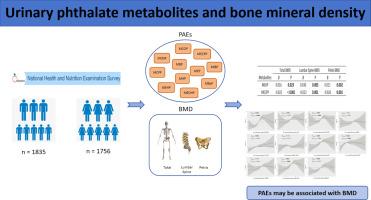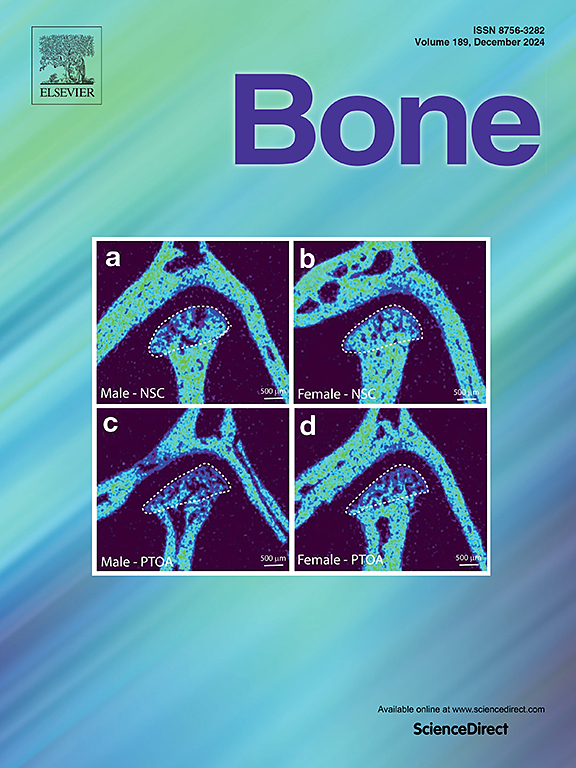Urinary phthalate metabolites associated with bone mineral density in adults: Data from the NHANES 2011–2018
IF 3.5
2区 医学
Q2 ENDOCRINOLOGY & METABOLISM
引用次数: 0
Abstract
Phthalates (PAEs) are common environmental endocrine disruptors and environmental bone poisons that can reduce bone mineral density (BMD). The purpose of this study is to investigate whether the concentration of PAE metabolites in urine is related to BMD in many parts of adult bones. We examined a series of cross-sectional data of male (n = 1835) and female (n = 1756) participants aged 18 to 59 years old in the National Health and Nutrition Examination Survey from 2011 to 2018 and measured urine PAE metabolites and dual-energy X-ray absorption to determine BMD (total body, lumbar spine, and pelvis). We used linear regression to test the correlation between a single phthalate biomarker and BMD. After adjusting all confounding variables, MEHP was positively correlated with BMD of total body, lumbar spine and pelvis, and BMD levels of the total body, lumbar spine and pelvis decreased with the increase of MECPP concentration. We used the restricted cubic spline function to test the nonlinear correlation between PAE biomarkers and BMD. The results show that urinary PAE metabolites have a nonlinear relationship with total body BMD, lumbar spine BMD, and pelvic BMD. With the increase in the PAE concentration, the BMD level first increased and then decreased, showing an inverted U-shaped trend (P < 0.05). Gender stratification also shows the same related trend. PAEs may be related to the BMD of adults. When the concentration of PAEs increases to a certain threshold, it will lead to a significant decrease in BMD.

与成人骨矿物质密度相关的尿液邻苯二甲酸酯代谢物:2011-2018年国家健康调查(NHANES)数据
邻苯二甲酸盐(PAEs)是常见的环境内分泌干扰物和环境骨毒,可降低骨矿物质密度(BMD)。本研究的目的是探讨尿液中 PAE 代谢物的浓度是否与成人骨骼许多部位的 BMD 有关。我们研究了2011年至2018年全国健康与营养调查中18至59岁男性(n = 1835)和女性(n = 1756)参与者的一系列横断面数据,并测量了尿液中的PAE代谢物和双能X射线吸收测定BMD(全身、腰椎和骨盆)。我们使用线性回归来检验单一邻苯二甲酸酯生物标志物与 BMD 之间的相关性。在调整所有混杂变量后,MEHP 与全身、腰椎和骨盆的 BMD 呈正相关,而全身、腰椎和骨盆的 BMD 水平随着 MECPP 浓度的增加而降低。我们使用受限三次样条函数检验了 PAE 生物标志物与 BMD 之间的非线性相关性。结果表明,尿液中的 PAE 代谢物与全身 BMD、腰椎 BMD 和骨盆 BMD 呈非线性关系。随着 PAE 浓度的增加,BMD 水平先升高后降低,呈倒 U 型趋势(P < 0.05)。性别分层也显示出同样的相关趋势。PAEs 可能与成人的 BMD 有关。当 PAEs 浓度增加到一定临界值时,会导致 BMD 显著下降。
本文章由计算机程序翻译,如有差异,请以英文原文为准。
求助全文
约1分钟内获得全文
求助全文
来源期刊

Bone
医学-内分泌学与代谢
CiteScore
8.90
自引率
4.90%
发文量
264
审稿时长
30 days
期刊介绍:
BONE is an interdisciplinary forum for the rapid publication of original articles and reviews on basic, translational, and clinical aspects of bone and mineral metabolism. The Journal also encourages submissions related to interactions of bone with other organ systems, including cartilage, endocrine, muscle, fat, neural, vascular, gastrointestinal, hematopoietic, and immune systems. Particular attention is placed on the application of experimental studies to clinical practice.
 求助内容:
求助内容: 应助结果提醒方式:
应助结果提醒方式:


